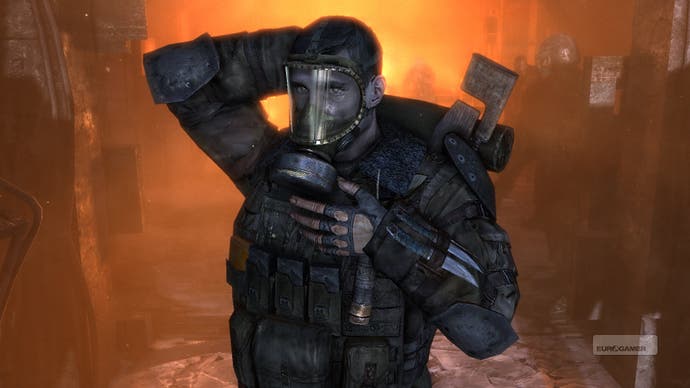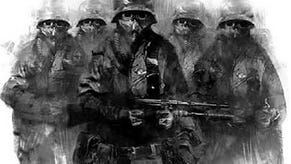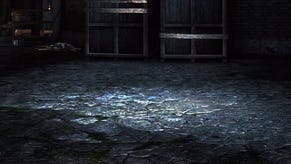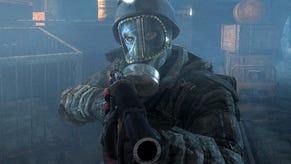Metro 2033
Going underground.
Appropriately, the PC version is being held up as a flagship offering by NVIDIA, with PhysX support promising to provide a more believable physics system and physically driven animation. To ram the point home, THQ has produced a document listing every last technical buzzphrase (my favourite: Hierarchical Per-pixel Occlusion Culling), but to the uninitiated, it's a game the more visually-minded gamer will be drawn to, regardless of whether you plump for the more sumptuous PC version or the slightly less spectacular Xbox 360 version.
What counts most, though, is how it feels to play, and during a 90-minute hands-on session there's much to admire. Crucially for a narrative-driven shooter, Metro 2033's paced thoughtfully and cinematically. Story and action elements are satisfyingly interwoven, with a pleasing degree of variety between trudging the corridors and gantries of the Metro system. Sometimes you're left fending off crazed mutants in a frenzy of action, and other times getting involved in a peek-and-sneak campaign against similarly-minded mercenaries with scant regard for your existence.
Perhaps inevitably for a game set in an underground train network, Metro 2033 also resorts to some gratuitous on-rails shooting when it feels appropriate, but happily it's not quite what you expect. One memorable sequence early on places you on the back of a hand-driven cart when, inexplicably, a ball of blue light renders everyone unconscious. With grizzled mutants leaping at you from all sides, your aim has to be true and timed to perfection to make the most of the slow-reloading double-barrel shotgun at your disposal.

You have to be slightly more dextrous than usual in the heat of the moment, mindful to fire the left barrel with the left trigger and the right barrel with the right trigger. Despite your successes, you're eventually hauled off and separated from your buddies anyway, only to be dramatically rescued at the death. This fragile tension persists throughout, with the game regularly tormenting you with impossible situations, only to offer subsequent resolution.
In terms of the general corridor-trawling exploration, it feels like a game with immense promise, providing 4A Games tightens a few core elements of the combat, such as the mutant AI, which only seems to charge headlong at the player rather than doing anything more predatory and adaptive.
Likewise, the physics system lacks conviction at the moment, despite the NVIDIA fanfare, with enemies continuing to encroach until the prescribed amount of damage is dealt, rather than recoiling as you shoot them with a shotgun. When they finally die, they fall over in a glitchy mess of confused ragdoll tech. To be fair to 4A Games, this is often common of unfinished code, but nevertheless it's clear there's still work to do before Metro 2033 sees the light of day.

Speaking of which, the demo climaxes with the game's first outdoor sequences. Providing a welcome change of scenery, you battle through the frozen, shattered remnants of once-proud Moscow, clambering over twisted wreckage and darting into abandoned buildings before inevitably being set-upon by progressively more nightmarish mutant enemies.
The game is said to clock in at around 10 hours, so a few eyebrows are raised when we're told there's no multiplayer, but the answer from the THQ camp is clear - they reckon it's better to focus on making a grand single-player experience, and add that in any case a multiplayer shooter taking place largely in tunnels might not work.
Metro 2033 aims to be one of those intensely cinematic experiences that keeps you entertained with an immersive setting, compelling story and terrifying, intense and claustrophobic atmosphere. Whether 4A Games can achieve this lofty aim remains to be seen, but despite the rather ragged feel of the combat, it's clear the potential is there to produce something special. With only a few months to go, we'll keep you posted in the run up to release.
Metro 2033 is coming to PC and Xbox 360 in spring 2010.








